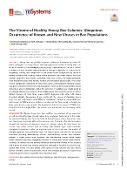| dc.contributor.author | Kadlečková, Dominika | |
| dc.contributor.author | Tachezy, Ruth | |
| dc.contributor.author | Erban, Tomáš | |
| dc.contributor.author | Deboutte, Ward | |
| dc.contributor.author | Nunvář, Jaroslav | |
| dc.contributor.author | Saláková, Martina | |
| dc.contributor.author | Matthijnssens, Jelle | |
| dc.date.accessioned | 2023-01-11T14:40:33Z | |
| dc.date.available | 2023-01-11T14:40:33Z | |
| dc.date.issued | 2022 | |
| dc.identifier.uri | https://hdl.handle.net/20.500.14178/1640 | |
| dc.description.abstract | Honey bees are globally important pollinators threatened by many different pathogens, including viruses. We investigated the virome of honey bees collected at the end of the beekeeping season (August/September) in Czechia, a Central European country. Samples were examined in biological replicates to assess the homogeneity, stability, and composition of the virome inside a single hive. By choice of healthy workers from colonies, where Varroa destructor was under control, we could identify ubiquitous bee viruses. Deformed wing virus (DWV) was highly prevalent, even though the bees were healthy, without any noticeable disease signs. The overall virome composition (consisting of honey bee-, plant-, and bacterium-infecting viruses) was driven primarily by the hive and its location. However, honey bee-specific viruses showed an uneven distribution within the same hive. In addition, our results point to an unusual cooccurrence between two rhabdoviruses and reveal the presence of five distinct lineages of Lake Sinai viruses (LSVs) clustering with other LSV strains described globally. Comparison of our results with the virome of Australian honey bees, the last truly Varroa- and DWV-free population, showed a strong difference with respect to DWV and a set of diverse members of the Picornavirales, of which the latter were absent in our samples. We hypothesize that the occurrence of DWV introduced by Varroa strongly affects the virome structure despite the mite being under control. IMPORTANCE The Western honey bee, Apis mellifera, is a vital part of our ecosystem as well as cultural heritage. Annual colony losses endanger beekeeping. In this study, we examined healthy bees from the heart of Central Europe, where honey bee colonies have been commonly affected by varroosis over 5 decades. Our virome analysis showed the presence of ubiquitous viruses in colonies where the mite Varroa destructor was under control and no honey bee disease signs were observed. Compared to previous studies, an important part of our study was the analysis of multiple replicates from individual hives. Our overall results indicate that the virome structure (including bee-infecting viruses, plant-infecting viruses, and bacteriophages) is stable within hives; however, the bee-infecting viruses varied largely within interhive replicates, suggesting variation of honey bee viruses within individual bees. Of interest was the striking difference between the viromes of our 39 pools and 9 pools of honey bee viromes previously analyzed in Australia. It could be suggested that Varroa not only affects DWV spread in bee colonies but also affects diverse members of the Picornavirales, which were strongly decreased in Czech bees compared to the Varroa- and DWV-naive Australian bees. | en |
| dc.language.iso | en | |
| dc.relation.url | https://doi.org/10.1128/msystems.00072-22 | |
| dc.rights | Creative Commons Uveďte původ 4.0 International | cs |
| dc.rights | Creative Commons Attribution 4.0 International | en |
| dc.title | The Virome of Healthy Honey Bee Colonies: Ubiquitous Occurrence of Known and New Viruses in Bee Populations | en |
| dcterms.accessRights | openAccess | |
| dcterms.license | https://creativecommons.org/licenses/by/4.0/legalcode | |
| dc.date.updated | 2023-11-07T08:11:52Z | |
| dc.subject.keyword | Apis mellifera | en |
| dc.subject.keyword | Picornavirales | en |
| dc.subject.keyword | rhabdovirus | en |
| dc.subject.keyword | Lake Sinai virus | en |
| dc.subject.keyword | metagenomics | en |
| dc.subject.keyword | viruses | en |
| dc.relation.fundingReference | info:eu-repo/grantAgreement/EU/FP8/MiCoBion | |
| dc.relation.fundingReference | info:eu-repo/grantAgreement/CELSA/CELSA/CELSA/17/ | |
| dc.relation.fundingReference | info:eu-repo/grantAgreement/MZE/QK/QK1910018 | |
| dc.relation.fundingReference | info:eu-repo/grantAgreement/UK/SVV/SVV260568 | |
| dc.date.embargoStartDate | 2023-11-07 | |
| dc.type.obd | 73 | |
| dc.type.version | info:eu-repo/semantics/publishedVersion | |
| dc.identifier.doi | 10.1128/msystems.00072-22 | |
| dc.identifier.utWos | 000797870600001 | |
| dc.identifier.eidScopus | 2-s2.0-85132577607 | |
| dc.identifier.obd | 614711 | |
| dc.identifier.riv | RIV/00216208:11310/22:10447053 | |
| dc.identifier.pubmed | 35532210 | |
| dc.subject.rivPrimary | 10000::10600::10607 | |
| dc.relation.datasetUrl | https://www.ncbi.nlm.nih.gov/bioproject/?term=PRJNA781422 | |
| dcterms.isPartOf.name | mSystems | |
| dcterms.isPartOf.issn | 2379-5077 | |
| dcterms.isPartOf.journalYear | 2022 | |
| dcterms.isPartOf.journalVolume | 7 | |
| dcterms.isPartOf.journalIssue | 3 | |
| uk.faculty.primaryId | 115 | |
| uk.faculty.primaryName | Přírodovědecká fakulta | cs |
| uk.faculty.primaryName | Faculty of Science | en |
| uk.department.primaryId | 1034 | |
| uk.department.primaryName | Katedra genetiky a mikrobiologie | cs |
| uk.department.primaryName | Department of Genetics and Microbiology | en |
| dc.description.pageRange | nestránkováno | |
| dc.type.obdHierarchyCs | ČLÁNEK V ČASOPISU::článek v časopisu::původní článek | cs |
| dc.type.obdHierarchyEn | JOURNAL ARTICLE::journal article::original article | en |
| dc.type.obdHierarchyCode | 73::152::206 | en |
| uk.displayTitle | The Virome of Healthy Honey Bee Colonies: Ubiquitous Occurrence of Known and New Viruses in Bee Populations | en |

